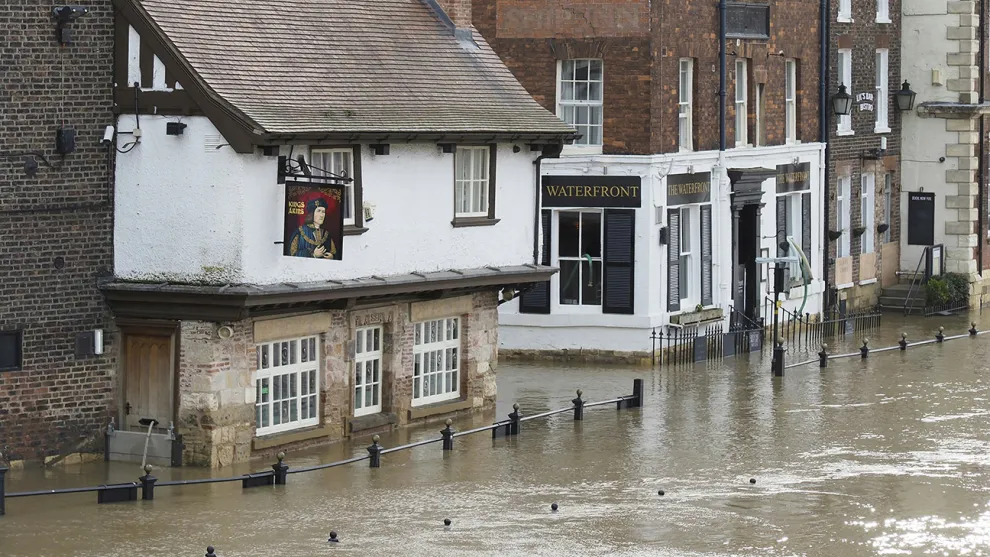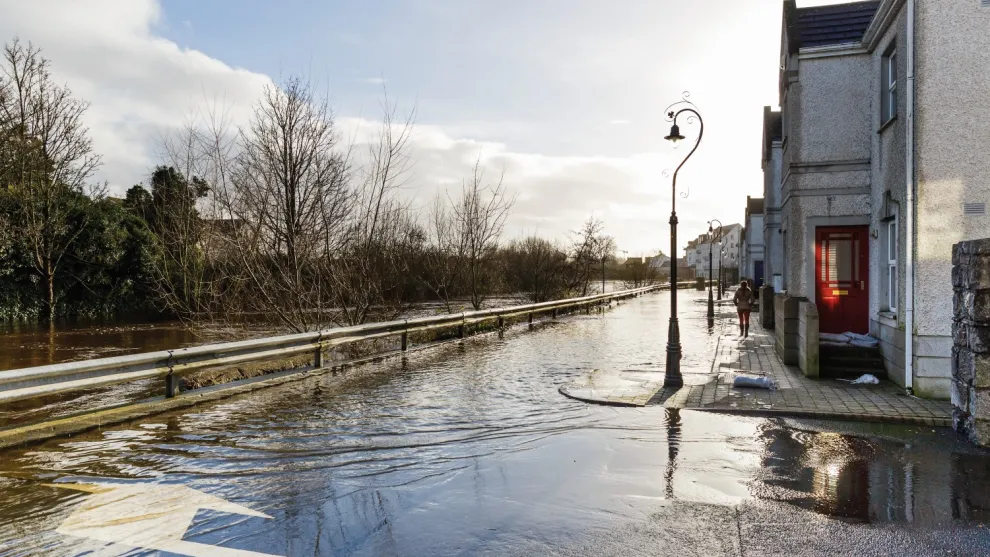The Rising Tide of Flood Challenges in the UK

From the devastating impact of coastal floods brought on by storm surges to the widespread consequences of river and pluvial floods, we’ll be looking at these natural phenomena and the recent flood events that have marked a turning point in the UK's climatic history, highlighting the urgent need for effective flood management and resilience strategies.
The intricate relationship between climate change and flooding is also explored, revealing how a warming climate contributes to the frequency and severity of these events. Looking ahead, the article presents future forecasts, underscoring the increasing flood risks and the critical need for adaptive strategies.
The impacts of flooding on health, the environment and infrastructure are discussed in-depth, followed by an analysis of the current state of the UK's flood defences and the systemic issues plaguing them.
Types of floods
Before we explore the increasing prevalence of flooding and the impact it has on communities, the environment and infrastructure, let's start by looking at the three main types of flooding experienced in the UK.
Coastal floods
Coastal flooding is a major concern for communities along the UK coast. It occurs when land areas along the coast are inundated by seawater. The most common causes are intense windstorm events coinciding with high tides, known as storm surges.
Storm surges, caused by high winds from a windstorm pushing seawater onshore, are particularly severe when they coincide with high tides, leading to significant storm surge floods. The extent of damage in coastal flooding depends on factors such as the strength, size, speed and direction of the windstorm, as well as the local topography.
Fluvial or river floods
Fluvial or river flooding occurs when water levels in rivers, lakes or streams rise and overflow onto the surrounding banks, shores and adjacent land. This rise in water levels can be due to excessive rainfall or snowmelt.
The impact of a river flood can be extensive, affecting not only the immediate area but also smaller rivers downstream, potentially leading to the breaching of dams and dikes and inundating nearby areas. The severity of a river flood depends on factors like the duration and intensity of rainfall in the river's catchment area, previous rainfall leading to soil water saturation and the surrounding terrain.
Pluvial floods
Pluvial flooding happens independently of overflowing water bodies, following extreme rainfall events. This type of flooding can occur anywhere, urban or rural, and does not require proximity to a body of water. There are two types of pluvial floods:
Surface water floods
These occur when urban drainage systems are overwhelmed, leading to water spilling onto streets and into buildings. This type of flooding develops gradually, usually allowing time for evacuation, and the water levels are typically shallow. While not posing an immediate threat to life, they can cause significant economic damage.
Flash floods
These are characterised by a rapid, high-velocity torrent of water, triggered by torrential rain falling in a short period, either in the vicinity or on nearby elevated terrain. They can also result from the sudden release of water from levees or dams upstream. Flash floods are particularly dangerous and destructive, not only due to the force of the water but also because of the debris that is often swept along with it.
Recent UK flood events
The latter half of 2023 marked a significant period in the UK's climatic history, with unprecedented levels of rainfall and flooding. According to the UK Centre for Ecology and Hydrology, from July to December 2023, the UK experienced its wettest period since records began in 1890.
This period was characterised by an autumn (September to November) that saw rainfall levels 22% above the average, followed by an exceptionally wet December, where certain areas in central and northern England, along with eastern Scotland, received rainfall 70% above the average.
The impact of this excessive rainfall was profound. By the morning of Wednesday 3 January 2024, nearly 700 flood alerts and warnings were issued in England and Wales. This situation was exacerbated by a series of storms (Babet, Ciaran, Debi Elin, and Fergus) that struck in quick succession during the autumn months. These storms left river catchments full and the ground saturated, setting the stage for severe flooding when Storm Henk arrived. The intense rainfall from these storms had limited places to go, leading to rapid runoff into rivers and causing many to overflow their banks.
In October and November 2023, England was particularly hard hit by heavy, persistent, and widespread rain due to Storms Babet and Ciaran. The Environment Agency reported that Storm Babet alone resulted in the flooding of 2,200 homes by the end of October.
Surface water flooding has become an increasingly pressing issue, with 3.4 million properties in England at risk. A notable example of this was in July 2021, when parts of London received a month's worth of rainfall in just a few hours, leading to over 1,500 properties being flooded due to surface water.
Some 5.7 million properties were at risk of flooding in England in 2022 and 2023 and this number is expected to increase as climate breakdown brings more intense downpours more often. Recent flood events serve as a stark reminder of the increasing challenges posed by extreme weather conditions and the urgent need for effective flood management and resilience strategies.

Climate change and flooding
The relationship between climate change and flooding in the UK is becoming increasingly evident and concerning. As we progress further into an era of climate change, the patterns of rainfall and storm frequency are shifting, leading to more frequent and severe flooding events.
The warming climate is a key driver of these changes. One of the primary effects of a warmer climate is the increased intensity of rainfall. This is due to the principle that warmer air can hold more water, leading to heavier downpours. This heightened rainfall intensity can quickly overwhelm river catchments, leading to rapid and severe flooding. Additionally, it can cause direct surface water flooding, where persistent heavy rain transforms roads into rivers, and water flows into areas that are typically not prone to flooding.
Another significant concern linked to climate change is the rise in sea levels. Sea levels have been steadily increasing year after year and are projected to continue rising for centuries, even if global emissions are significantly reduced in the coming decades. This gradual rise in sea levels exacerbates the risk of coastal flooding. It increases the likelihood that storm surges will breach coastal defences, potentially leading to more frequent and severe coastal flooding events. Moreover, the combination of high sea levels, storm surges, high river levels and surface water flooding can lead to compound flooding events along the coast.
Future forecasts
The outlook for flooding in the UK in the coming decades is a real cause for concern, with both the frequency and severity of flood events expected to rise.
The number of people in the UK living in areas prone to flooding is set to increase due to factors such as sea-level rise, which is identifying new at-risk areas. The increase in flood risk in the UK is largely driven by coastal flooding and will predominantly impact England.
The degree of future flood risk is closely tied to global warming. Projections indicate that by 2050, under a modest warming scenario of 2°C, the number of people in the UK significantly at risk of flooding could increase by 61%. In a high warming scenario of 4°C, this figure could soar to 118%.
The extent of sea-level rise is largely dependent on the planet's warming degree. There is a projected difference of 1 metre to 1.5 metres in sea levels between scenarios of low and high levels of warming. The higher end of this spectrum could necessitate the relocation of some coastal communities in the UK and would have profound effects on infrastructure and services, leading to adverse health outcomes.
An interactive risk map from Climate Central forecasting the UK's landscape in 2050 paints a distressing picture. It predicts that, without significant action against global warming, large parts of the country could be submerged in less than 30 years.
The east and north-east of England are anticipated to be the worst affected. An extensive area, stretching from above Cambridge to Hull along the coast, is projected to be underwater. By 2050, it is estimated that over 1.3 million households in the UK will be at substantial risk of flooding, marking an increase of 250,000 from current levels.
These developments underscore the critical need for adaptive strategies and robust infrastructure to manage the evolving flood risks associated with climate change. It is clear that as the climate continues to warm, the UK must prepare for more frequent and intense flooding events, both inland and along its coastlines.

The impact of flooding
The implications of increased flooding are far-reaching. Here, we’ll be looking at the various impacts of increasing flooding in the UK, highlighting the urgent need for robust response strategies and resilience planning to mitigate these effects on health, the environment and infrastructure.
Health
The health impacts of flooding are both immediate and long-term, affecting physical and mental well-being. Direct health effects include drowning, which can occur when individuals attempt to walk or drive through floodwaters, physical trauma from hidden or displaced objects, electrocution, fire and infections from exposure to contaminated water.
Longer-term health consequences are equally concerning. These include carbon monoxide poisoning from improper use of generators, respiratory diseases due to mould and damp conditions and rodent-borne diseases.
Recognising that there are also mental health issues connected with flooding, the UK Health Security Agency has published guidance specifically addressing this aspect. This guidance aims to mitigate major psychological effects by informing people about the health impacts of flooding and providing strategies for preparation and response.
Environment
Coastal flooding has a profound impact on the environment, affecting various ecosystems on different scales. It can destroy vital coastal habitats like wetlands and estuaries, erode dune systems and lead to significant biodiversity loss, potentially causing species extinctions.
These coastal features also act as natural buffers against storm waves. However, their degradation due to consistent flooding and sea-level rise diminishes this protection, allowing waves to reach further inland, which exacerbates erosion and increases the risk of further coastal flooding.
The environmental impact extends to agriculture, with prolonged seawater inundation leading to soil salination, severely reducing agricultural productivity. Floodwaters can destroy food crops and forests, while saltwater intrusion can devastate freshwater bodies, affecting their role as habitats and sources of drinking water.
Infrastructure
The UK's infrastructure is increasingly vulnerable to the intensifying flood risks. Up to 11% of road infrastructure, 51% of water supply infrastructure, 25% of gas infrastructure, 77% of rail infrastructure and 21% of electricity infrastructure are at risk. Railways and roads in particular struggle to cope with flooding from intense rainfall events and increased urban runoff, exacerbated by urban expansion.
Communities and streets that have never experienced flooding are now facing increased risks, particularly in areas where construction has occurred on marginal land. The agricultural sector is also impacted, as farmlands are often used for flood relief, limiting food production capacity and threatening the economic viability of farming.
Water supply and sewage systems are under strain too from the combination of intense rainfall and increased urban runoff. This challenge is compounded by population growth, higher daily water usage and the ongoing development of green-field sites. Additionally, while the electricity grid and network of substations have received enhanced protection following severe floods, they remain susceptible to extreme weather events.
The increasing frequency and severity of flooding in the UK necessitate urgent and comprehensive measures to mitigate these wide-ranging impacts on health, the environment, and infrastructure.
Current UK flood defences: a cause for concern
England's flood defence system is facing a critical challenge, with a significant number of its defences in a state of disrepair, rendering them nearly ineffective. This issue has been highlighted by the storms of late 2023 and early 2024, which have exposed the vulnerabilities in the system.
In the 10 English counties most severely affected by the recent extreme weather events, nearly 800 critical flood defence assets (those crucial for protecting life and property) were reported to be in either ‘poor’ or ‘very poor’ condition. An investigation by Unearthed, Greenpeace UK's investigative arm, revealed that in 2022, approximately 4,204 of England's key flood defences were categorised as poor or very poor. This figure represents about one in 15 of all the flood defences across the country.
Of these, 856 were in a ‘very poor’ state, indicating severe defects that lead to complete failure in performance, essentially making them non-functional. The other 3,348 were classified as ‘poor’, with defects significantly reducing their effectiveness. Despite the Environment Agency, which owns and maintains over half of these defences in England, reporting an improvement in the latest financial year (from one in 15 to one in 20 in disrepair), the situation remains dire. The Agency has acknowledged the need for contingency plans for critical defences in poor condition.
Why are they so poor?
To effectively tackle the ongoing crisis, it's essential to thoroughly investigate the underlying reasons for the shortcomings in our flood defence systems. Research conducted by Unearthed has brought to light three systemic issues that contribute to these inadequacies:
Outdated infrastructure
Much of the existing flood defence infrastructure was designed decades ago, without accounting for the evolving climate and its associated challenges. With rising sea levels, increased rainfall and more frequent and severe storms, there is an urgent need to reassess and update UK infrastructure to meet current and future demands.
Inadequate funding
A primary factor contributing to the poor state of flood defences is inadequate funding. As the impacts of climate change intensify, the need for resilient and adaptable flood defence infrastructure becomes more critical. However, budget limitations have been a significant barrier to the necessary upgrades and maintenance.
Absence of strategic planning
A strategic, comprehensive approach is essential for effective flood defence. However, the current system suffers from a lack of such planning, leading to a disjointed and inadequate defence network. It is crucial to develop and implement integrated long-term strategies that consider the connections between rivers, urban areas and coastal zones to establish a robust and cohesive flood defence system.
The Environment Agency needs to be well-resourced for the long term, and the government’s £5 billion plan announced in 2020 has helped to speed up the creation of new flood defences in recent years. But there is no level of resourcing for flood defences that would mean every home in England, or every piece of farmland was protected from being flooded.

Analysing the solutions that Aggregate Industries can provide
Here at Aggregate Industries, we have an array of Sea and Flood Defence aggregate solutions that are well-suited to cater to the evolving requirements in a world where rising sea levels are an increasing concern.
In this section, we’ll examine four primary products that are already making a significant impact around the UK:
Sustainable Drainage Systems (SuDS)
SuDS, or Sustainable Drainage Systems, presents an innovative and eco-conscious approach to managing surface water runoff in urban and rural areas. Departing from conventional systems that swiftly channel water away, SuDS prioritise sustainability by replicating natural processes to reduce flooding, enhance water quality, and foster biodiversity. These systems incorporate various techniques like permeable surfaces, green roofs, swales, detention basins, and infiltration devices, allowing rainwater absorption or slowdown. SuDS not only mitigate flooding risks but also act as natural filters, removing pollutants and improving water quality before reaching water bodies, thereby demonstrating a commitment to sustainable, environmentally friendly drainage solutions.
Hydromedia
Hydromedia is an advanced porous concrete solution designed to address urban water management challenges and promote sustainable development. Composed of a specialised mix of aggregates, cement, and water-permeable additives, Hydromedia facilitates rapid water drainage, reducing surface runoff and minimising the risk of flooding. Its porous nature allows rainwater to infiltrate the surface, replenishing groundwater and preventing the strain on traditional drainage systems. Beyond its functionality, Hydromedia also contributes to improved water quality by filtering out impurities as water permeates through the concrete.
SuperDrain Asphalt
SuperDrain Asphalt stands as an innovative and sustainable solution which addresses crucial issues in water management and urban resilience. This specialised asphalt product is engineered with advanced permeability features, allowing it to efficiently manage surface water runoff in urban areas. Unlike traditional asphalt surfaces, SuperDrain facilitates rapid water infiltration, reducing the risk of flooding and minimising strain on conventional drainage systems. Its unique composition promotes groundwater recharge and helps maintain water quality by filtering impurities as water passes through the asphalt.
Armourstone
Armourstone stands as a robust and versatile solution for coastal protection and erosion control. This specialised material, typically large, durable stones, serves as a protective barrier against the forces of nature, preventing erosion and safeguarding coastal infrastructure. Deployed strategically, Armourstone absorbs wave energy, mitigates the impact of storms, and provides long-lasting stability to shorelines. Beyond its formidable protective qualities, Armourstone enhances the aesthetic appeal of coastal areas, seamlessly blending functionality with natural beauty.
You can find out more about Aggregate Industries; solutions by visiting here.
Conclusions
The increasing frequency and severity of floods in the UK, as highlighted in this article, underscore the urgent need for comprehensive and sustainable flood prevention measures. The diverse nature of flooding and its impacts on communities and infrastructure necessitate a robust response.
Recent events, marked by unprecedented rainfall and intense storms, have not only caused immediate damage but also highlighted long-term challenges due to climate change. With forecasts predicting a rise in flood frequency and severity, the impacts extend to health, essential services and critical infrastructure, emphasising the need for resilient systems.
However, it's important to acknowledge that no level of resourcing for flood defences can guarantee complete protection for every home or piece of farmland in England. This reality underscores the need for a multifaceted approach to flood management, combining physical defences with strategic planning and community preparedness.
As the climate evolves, ensuring the safety and sustainability of communities and infrastructure against future flooding is crucial, while recognising the inherent limitations of flood defence systems.









